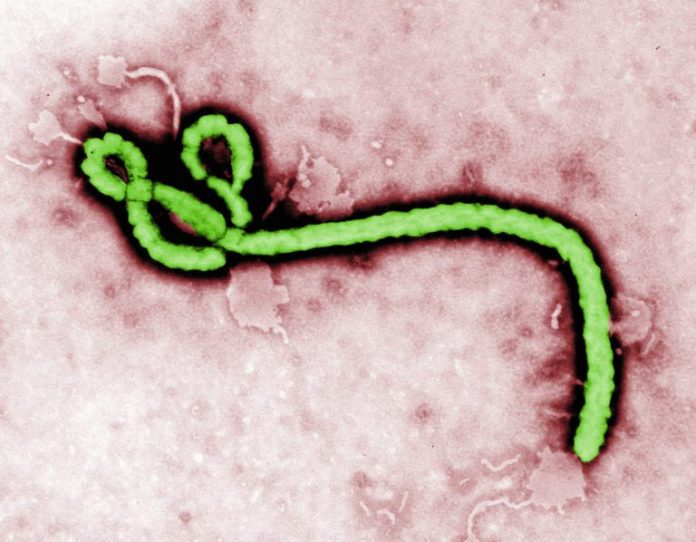Civil unrest may have worsened the ongoing Ebola outbreak in the Democratic Republic of Congo (DRC), according to a new study by Texas A&M College of Veterinary Medicine & Biomedical Sciences researcher Dr. Martial Ndeffo.
Published in the Proceedings of the National Academy of Sciences of the United States of America (PNAS), the research team—including scholars from Yale University, the University of Florida, and the University of Bordeaux—found that disruptive events, such as attacks on Ebola treatment centers and healthcare workers, reduced population-level vaccine effectiveness in the DRC by 43 percent.
Prior to disruptive events, the population-level vaccine effectiveness was estimated to be 52 percent; in the observed period of conflict, it was estimated to reach a minimum of 4.8 percent.
The eastern DRC is facing one of its most severe Ebola outbreaks on record, with 2,084 cases and 1,405 deaths since April 30, 2018. The country also is currently engulfed in conflict surrounding politics, ethnicity, land ownership, and economics. The mining regions of North Kiva and Ituri face conflict from more than 70 armed groups.
The research evaluated ethnographic evidence, such as civilian interactions with healthcare workers, and data relating the timeline of conflict to disease trends. Between Aug. 12, 2018, and June 23, 2019, the researcher team’s model predicted an average population-level vaccine effectiveness of 29.5 percent.
“With respect to Ebola, maintaining a high population-level vaccination effectiveness relies on good tracking of who has contact with infected individuals,” Ndeffo said. “Thus, when contact tracing becomes logistically challenging due to violence and conflict, a drop in population-level vaccination effectiveness can allow for the disease to enter new communities and be temporarily undetected.”
The study also evaluated the reproductive number of the disease, or how many new cases each existing case generates on average. For example, a reproductive number of 2 means that each diseased individual infects two more people, on average.
During the research observation period, Ebola’s reproductive number at times below 1. This indicates that each case was, on average, infecting less than one person, suggesting a declining trend in disease spread. In times of conflict, the reproductive number was driven above 1, indicating that each diseased individual was infecting more than one person, on average.
The study says that during disruptive events, the time from the first appearance of symptoms to safely containing the infected individual, or time to isolation, was on average extended by 1.91 days. This could in part be attributed to conflict episodes disrupting the tracing of chains of transmission or the tracking of who is infected and who interacts with infected individuals.
“The negative effects of extended time from symptom onset to isolation is that the individual is spending more time in the general community, increasing the risk of further spread of the disease,” Ndeffo said. “This extended time to isolation is also attributed to these individuals not being in known chains of transmission. Thus, this unknown chain of transmission can grow in an undetected manor, making the public health response that much more difficult down the road.”
The impact of conflict on the time it takes to isolate an infected individual, population-level vaccine effectiveness, and reproductive number can inform health officials of the larger picture of the effect conflict has had on public health response over the course of this Ebola outbreak. In addition to these quantitative statistics, ethnographic evidence provided in this study also takes into account the cultural and social impact that violent conflict has on disease response, Ndeffo said.
“Our ethnographic evidence indicates increased hostility of the public toward healthcare responders prior to an attack, which would impede the effectiveness of the public health response,” Ndeffo said. “Through our analysis, we show that a declining trend in Ebola incidence can be reversed as a result of violence toward the response and how they contribute to the persistence of the epidemic.”
Solutions to the observations presented in this study may be focused on conflict resolution in addition to medical intervention. Both a reduction in violence and support of humanitarian work are necessary to restore order and rebuild infrastructure in the affected area. Ndeffo places emphasis on the importance of gaining local trust of healthcare workers. This research could also help public health officials address the treatment of outbreaks of other diseases in other areas.
“The model we developed can seemingly be adjusted to simulate outbreaks of other disease in other conflict affected areas and examine the effects of conflict on disease incidence and public health control measures,” Ndeffo said. “There are other regions in the world where violence and conflict can impact the spread of other infectious diseases besides Ebola.
“This work also highlights the importance of coupling the public health response with humanitarian responses in the area to hopefully reduce the number of attacks toward healthcare workers and the facilities.”















